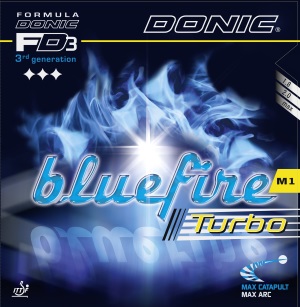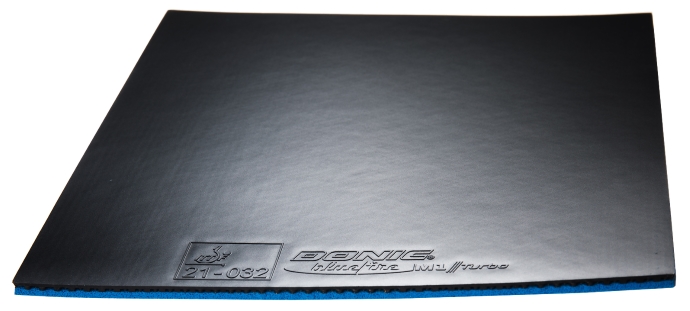Donic Bluefire M1 Turbo Review – Excellent Control for Short Play and Looping, Along With High Top End Speed
09 May 2018 | Posted in: Table Tennis Equipment
About the Reviewer
 Patrick Hrdlicka is a table tennis enthusiast, who was introduced to the sport by his parents at the age of six. Patrick progressed to play in the highest national cadet and junior team leagues in his native Denmark and was among the top 40 players in his age group, which fostered several long-standing members of the Danish National Team. With college looming, Patrick quit the sport for almost twenty years. During this hiatus, he obtained a Ph.D.-degree in chemistry and accepted a position as professor of chemistry at the University of Idaho.
Patrick Hrdlicka is a table tennis enthusiast, who was introduced to the sport by his parents at the age of six. Patrick progressed to play in the highest national cadet and junior team leagues in his native Denmark and was among the top 40 players in his age group, which fostered several long-standing members of the Danish National Team. With college looming, Patrick quit the sport for almost twenty years. During this hiatus, he obtained a Ph.D.-degree in chemistry and accepted a position as professor of chemistry at the University of Idaho.
At the beginning of 2014, the mid-life crisis and yearning for table tennis grew too strong for Patrick and he decided to pick up the sport again. Bitten again by the table tennis bug, he plays 4-6 times per week.
Since his comeback to table tennis, he has enjoyed combining his analytical and experimental skills with his love for table tennis, testing and reviewing a wide range of table tennis equipment.
 Although the Donic Bluefire M1 Turbo (BM1T) already has been on the market for a couple of years (it appeared on ITTF’s List of Approved Racket Coverings in 2014), I wanted to evaluate this rubber for two reasons. First, having played for extended periods of time with - and therefore appreciating the strengths and limitations of – top-end Chinese rubbers like DHS Hurricane 3 Neo and European rubbers like Tibhar Evolution MX-P, I wanted to try a rubber that straddles these two worlds. Moreover, the BM1T was – along with the Bluefire Japan 01 Turbo - the last top-end offering from Donic prior to the release of their Bluestorm series last year. The BM1T therefore serves as an important reference point.
Although the Donic Bluefire M1 Turbo (BM1T) already has been on the market for a couple of years (it appeared on ITTF’s List of Approved Racket Coverings in 2014), I wanted to evaluate this rubber for two reasons. First, having played for extended periods of time with - and therefore appreciating the strengths and limitations of – top-end Chinese rubbers like DHS Hurricane 3 Neo and European rubbers like Tibhar Evolution MX-P, I wanted to try a rubber that straddles these two worlds. Moreover, the BM1T was – along with the Bluefire Japan 01 Turbo - the last top-end offering from Donic prior to the release of their Bluestorm series last year. The BM1T therefore serves as an important reference point.
Donic’s marketing material asserts that the BM1T has been made using the Formula Donic FD3 technology, i.e., Lifetime Plus, Catapult Plus, and Tension Plus, which offers the prospect for longer durability, maximum catapult, and a sensational feeling on topspin strokes, which can be played with high arc and maximal spin. Donic recommends the BM1T for all-out attacking players and rates this rubber at 10++, 10+++, and 6 in speed, spin, and control, respectively.
The BM1T comes in sturdy cardboard packaging, which is kept in black, blue, silver and yellow color tones. Key rubber characteristics are listed on the back of the packaging. A description of Donic-sponsored players and the Formula Donic 3rd generation technology is provided on the inside of the cardboard cover. The sparkly top-sheet feels very grippy, but is entirely non-tacky. The pips, which Donic describes as long and narrow, have the shape of truncated cones. The 50-degree blue sponge has large pores and a prominent sweet booster smell, yet it does not dome. The uncut rubber sheet weighed 74 g (169 x 170 mm) whereas the sheet weighed 53 g when cut to the 156 x 151 mm test blade. This renders the BM1T as the heaviest European rubber that I have tested so far. Tibhar’s Evolution MX-S and Xiom’s Omega V Asia weigh 51-52 g and only DHS’ Hurricane 8 and Nittaku’s Hurricane Pro 3 Turbo Orange weigh more (53-57 g). A quick and non-scientific press test suggested the following order of rubber hardness (from hardest to softest): Hurricane 3 Neo (40-degrees) provincial ≥ Nittaku Hurricane Pro 3 Turbo Orange > Tibhar Evolution MX-S ≥ Xiom Omega V Asia ≥ Donic Bluefire M1 Turbo > Xiom Omega V Tour ≥ Tibhar Evolution MX-P.
Testing procedure
I tested the brand-new and unboosted B1MT (black, max) on a Nittaku Ludeack blade, which has a classic 7-ply limba-ayous-ayous-ayous-ayous-ayous-limba construction. I used a well-worn sheet of Spinlord Waran 2 short pips in my BH (2.0 mm, red). I attached the rubbers using the Revolution 3 normal viscosity glue and tested the set-up over several sessions, playing drills and matches against my usual training partners. The DHS D40+ 3* plastic balls were used throughout the tests.
Playing impressions
The first couple of FH drives indicated that the Donic Bluefire M1 Turbo is slightly slower and with less catapult than other rubbers released around the same time such as Gewo’s nanoFLEX FT48 or Victas’ V>15 Extra. FH drives are very pleasant to play and the rubber offers high levels of control and predictability. The control offered by the BM1T on FH loops against heavy backspin is outstanding. The ball bites into the rubber, producing a medium to medium-high arc over the net with plenty of clearance and high levels of spin. Playing against my regular training partner who uses long pips in his BH with a pushblocking style that produces high levels of backspin, I was able to land combinations of diagonal and down-the-line FH loops with hitherto unparalled consistency.
Looping is facilitated by a softer-than-expected feeling, given the 50-degree sponge hardness; the BM1T feels and plays more like ~48 degrees. At moderate swing speeds, the BM1T feels a notch slower and more controlled than the abovementioned Gewo and Victas rubbers, or Tibhar’s Evolution MX-P. At very high swing speeds, however, a prominent catapult is engaged, resulting in a substantial speed increase, lengthening of the arc, but also reduction of control on counter-topspins and loop-drives. I adjusted for the catapult by relaxing my forearm and using ‘softer hands’ and this largely regained the control. The fact that the catapult only is engaged on very high impact shots allows the BM1T to be used at all distances from the table, which is useful.

I also found the BM1T to be comfortable for BH loops, which normally are not part of my repertoire as a short pips player. I could produce BH loops with a stable, medium to medium-high arc and high levels of spin. Hard-sponged rubbers like DHS Hurricane 3 or Tibhar Evolution MX-S typically necessitate excellent footwork for controlled loop execution and the BM1T is no exception. However, based on my experiences during match play, I would say the BM1T is a little more forgiving in this aspect.
Blocking with the B1MT is solid although the rubber perhaps feels livelier and softer than its stated 50-degree hardness would imply, probably because the catapult is activated. The BM1T is quite capable of absorbing incoming kinetic energy and allowing the player to redirect the shots and energy in the desired direction, regardless whether blocking passively or actively. Blocking is facilitated by the lack of spin sensitivity.
The B1MT also works well on flat hits. The smashes are not the fastest in the world, but still offer plenty of speed to place the ball out of reach for your opponent. The feeling of the B1MT in short play is brilliant. The lack of catapult on low-impact shots and low spin sensitivity allows for precise serve returns and drop shots, which can be played short and low with a heavy backspin. The low spin sensitivity, combined with the rubber’s excellent grip, also facilitates aggressive serve returns. The spin levels on serves are high but minimally lower than with softer European rubbers (and noticeably lower than with tacky Chinese rubbers).
Read Donic Bluefire M1 Turbo Customer Reviews & Get Our Best Price >>
Conclusion
The Donic Bluefire M1 Turbo is an excellent rubber, which offers an outstanding feel in short play and control on mid-fast loops. The BM1T has some of the strengths of typical Chinese rubbers like DHS Hurricane 3 Neo, but the rubber is less spin-sensitive and far livelier, especially on high-impact shots. The BM1T reminds me of a higher throwing and slightly more forgiving version of Tibhar’s Evolution MX-S. Some players might find the difference in speed levels at low- and very high-impact shots disconcerting at first but this will require minor adjustment. Players with different styles and skills can benefit from the B1MT, ranging from intermediate to expert, and from all-round to offensive players. The only clearly apparent downside to this rubber is its heavy weight.
Serves: 9/10
Serve receives and short game: 9.2/10
Looping: 9.2/10
Flat hitting: 9.2/10
Blocking: 9/10
Got any questions or comments? Let us know in the discussion section below!
Did you find this review helpful? Why not share it with your friends!
YOU MAY ALSO LIKE:
Nittaku Hurricane Pro 3 Turbo Orange Review
Xiom Omega V Pro / Euro / Asia / Tour Rubbers Review
Tibhar Evolution MX-S / MX-P / EL-S / EL-P / FX-S / FX-P Review
